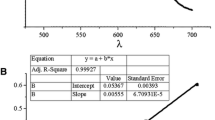Abstract
In this paper a study was made of the biodegradation of a non-ionic surfactant, a nonylphenol polyethoxylate, in biodegradability tests by monitoring the residual surfactant matter. The influence of the concentration on the extent of primary biodegradation, the toxicity of biodegradation metabolites, and the kinetics of degradation were also determined. The primary biodegradation was studied at different initial concentrations: 5, 25 and 50 mg/L, (at sub-and supra-critical micelle concentration). The NPEO used in this study can be considered biodegradable since the primary biodegradation had already taken place (a biodegradation greater than 80% was found for the different initial concentration tested). The initial concentration affected the shape of the resulting curve, the mean biodegradation rate and the percentage of biodegradation reached (99% in less than 8 days at 5 mg/L, 98% in less than 13 days at 25 mg/L and 95% in 14 days at 50 mg/L). The kinetic model of Quiroga and Sales (1991) was applied to predict the biodegradation of the NPEO. The toxicity value was measured as EC20 and EC50. In addition, during the biodegradation process of the surfactant a toxicity analysis was made of the evolution of metabolites generated, confirming that the subproducts of the biodegradation process were more toxic than the original.




Similar content being viewed by others
References
APHA, AWWA, WPCF (1992) Standard methods for the examination of water and wastewater. American Public Health Association, Washington, DC
Belanger S, Dorn P, Toy R, Boeije G, Marshall S, Wind T, Van Compernolle R, Zeller D (2006) Aquatic risk assessment of alcohol ethoxylates in North America and Europe. Ecotoxicol Environ Saf 64:85–99. doi:10.1016/j.ecoenv.2005.11.003
European Commission (EC) (2003) Directive 2003/53/EC of 18 June Restrictions on the marketing and use of certain dangerous substances and preparations (nonylphenol, nonylphenol ethoxylate and cement) Official Journal Eur Union L 178, 17/07/2003 P. 0024-0027
Jurado E, Fernández-Serrano M, Núñez-Olea J, Luzón G, Lechuga M (2002) Comparison and use of methods for the determination of non-ionic surfactants in biodegradation processes. Tenside Surfactants Deterg 39:154–159
Jurado E, Fernández-Serrano M, Núñez-Olea J, Lechuga M (2007) Primary biodegradation of commercial fatty-alcohol ethoxylate surfactants: characteristic parameters. J Surf Deterg 10:145–153. doi:10.1007/s11743-007-1027-5
Maguire R (1999) Rewiew of the persistente of nonylphenol and nonylphenol ethoxylates in aquatic environments. Water Qual Res J Can 34:37–78
Monod J (1949) The growth of bacterial cultures. Annu Rev Microbiol 3:371–394. doi:10.1146/annurev.mi.03.100149.002103
OECD (1993) Guideline for testing of chemicals, No. 301: Ready biodegradability. Paris, Cedex, France
Quiroga J, Sales D (1991) Surfactant biodegradation in sea water. Tenside Surfactants Deterg 28:200–203
Romero L (1991) Desarrollo de un modelo matemático general para los procesos ferménticos: cinética de la degradación anaerobia. Doctoral thesis, Cadiz University
Soares A, Murto M, Guieysse B (2006) Biodegradation of nonylphenol in a continuous bioreactor at low temperatures and effects on the microbial population. Appl Microbiol Biotechnol 69:597–606. doi:10.1007/s00253-005-0067-x
UNE EN ISO 11348-2 (1999) Wiley-VCH, Weinheim, Germany
Van Compernolle R, McAvoy D, Sherren A, Wind T, Cano M, Belanger S, Dorn P, Kerr K (2006) Predicting the sorption of fatty alcohols and alcohol ethoxylates to effluent and receiving water solids. Ecotox Environ Saf 64:61–74. doi:10.1016/j.ecoenv.2005.10.013
Zhang C, Valsaraj K, Constant W, Roy D (1999) Aerobic biodegradation kinetics of four anionic and non-ionic surfactants at sub- and supra-critical micelle concentrations (CMCs). Water Res 33:115–124. doi:10.1016/S0043-1354(98)00170-5
Zhao J, Zhang G, Qin Y, Zhao Y (2006) Aerobic biodegradation of alkylphenol ethoxylates. Bioresource Technol 97:2478–2480. doi:10.1016/j.biortech.2005.10.017
Author information
Authors and Affiliations
Corresponding author
Rights and permissions
About this article
Cite this article
Jurado, E., Fernández-Serrano, M., Núñez-Olea, J. et al. Aerobic Biodegradation of a Nonylphenol Polyethoxylate and Toxicity of the Biodegradation Metabolites. Bull Environ Contam Toxicol 83, 307–312 (2009). https://doi.org/10.1007/s00128-009-9716-6
Received:
Accepted:
Published:
Issue Date:
DOI: https://doi.org/10.1007/s00128-009-9716-6




